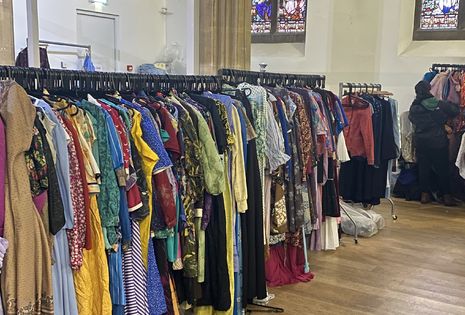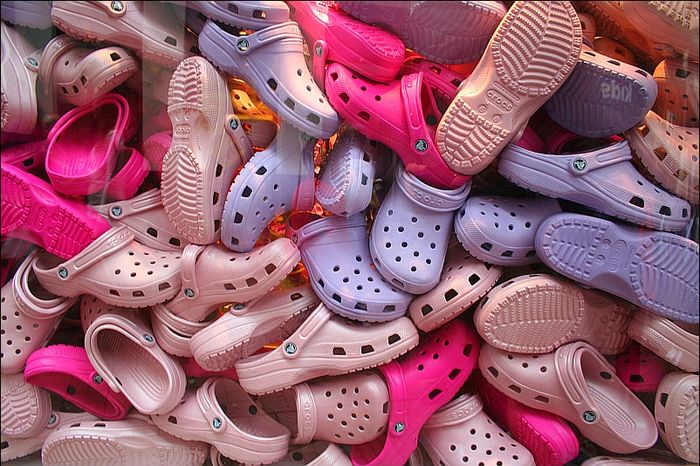Weighing up the pros and cons of kilo sales
The second-hand shopping sensation has massively grown in popularity in recent years. But on balance, are they really worth the hype?

I feel like I can’t go on Facebook these days for a painful scroll down Camfess without seeing at least one kilo sale ad peer-pressuring me into announcing to all my friends that I am in fact “interested”. Where there was once just one brand promising weight-based bargains, its existence has spawned an endless amount of copy varieties. So why has this phenomenon grown so popular?
For anybody who’s been living under a synthetic, mass-produced rock for the past few years, a kilo sale is a second-hand shopping experience where the price of your clothes is determined by their weight. Once you’ve spent the good part of an otherwise productive afternoon rummaging through ratty Adidas T-shirts and questionably patterned blouses in your local church or town hall, you then weigh your final haul to find out its cost.
“Why has this phenomenon grown so popular?”
Taking a step back, it seems rather a strange system. Although the idea of more clothes costing more makes sense, clothes obviously weigh varying amounts based on item, regardless of quality. You can practically get ten lightweight blouses for the same price as one leather jacket. However, it’s also fair to say that heavier items such as jeans, jackets, and jumpers do tend to be more expensive than things like T-shirts in non-weight-based shops anyway. But I’m sure there are a fair few people who have either been massively robbed or who have made an immense bargain from this concept. At the end of the day, it’s up to the consumer to be smart.

Talking to some students at one Cambridge kilo sale, one of them said they come to these sales “for the brands. Because it’s done by weight – a t-shirt like Ralph Lauren in a charity shop might be marked up but at a kilo sale it won’t matter.” Obviously, like all second-hand shopping, there is an element of luck. Sometimes there’s just a good offering, and sometimes there’s not. A pro tip is to get there as early as possible, but my top tip is to pick the right kilo sale brand. The first kilo sale I went to in Cambridge was amazing. I got a slip dress, a maxi skirt, a jumper – everything slotted perfectly into my Sidge girly wardrobe. I’m not going to name any names, but my second experience with a different brand left me surrounded by stained 80s grandma blouses and sports T-shirts that looked like they’d been fished straight out of a ten-year-old boy’s laundry basket.
“But at least you’re not just spending £2 on the feeling of disappointment and wasted time”
I did end up buying a turtleneck though. Did I really need it? No. Did I feel the need to buy it because I’d already paid a fee to get through the door? Yes. Many kilo sales insist on having a standard entry price to cover the basic cost of hosting the event. But that’s not how the rest of the commercial world operates. Surely you make money from your product, not from giving people the opportunity to purchase it. In making people pay entry, it makes you feel like you’re paying for the experience itself - something to romanticise into an ”event” with your friends (despite their often dingy underwhelming-ness). There’s a reason you’re coming here instead of getting caught in an eBay bidding war.
Although I understand where the organisers are coming from, entry fees also take away some of their accountability. They could fill the hall with the ugliest clothes in existence but they’re still going to take in cash. Sure, they might not make a profit this way, but it just seems a bit unfair that you can spend money at a sale and still walk out with nothing. Which is another twist in this tactic. Despite how illogical it is, something about spending money to get into the sale pressures you into at least buying something. Yeah, you’re now spending £6 instead of just the £2 entry fee for a £4 dress, but at least you’re not just spending £2 on the feeling of disappointment and wasted time. The students I spoke to said although this entry fee is “annoying”, ultimately “it’s not too bad.” Despite the fact they don’t “prefer kilo sales to charity shops” it is “a day out” they can enjoy with their friends.
In all honesty, I’ve found myself disappointed by most of the kilo sales I’ve attended. And I really don’t think they’re worth it unless you ensure you’re going to the good ones. The lack of changing rooms, the overwhelming amount of stuff, and the entry fee just make the whole thing a hassle. Yes, the right brand on the right day at the right time can sometimes provide you with hidden gems and a great time, but more often than not you’re better off just hitting up your local charity shops.
 Comment / Anti-trans societies won’t make women safer14 November 2025
Comment / Anti-trans societies won’t make women safer14 November 2025 Comment / Be mindful of non-students in your societies12 November 2025
Comment / Be mindful of non-students in your societies12 November 2025 News / Controversial women’s society receives over £13,000 in donations14 November 2025
News / Controversial women’s society receives over £13,000 in donations14 November 2025 News / Stolen plate returned to Caius after 115 years12 November 2025
News / Stolen plate returned to Caius after 115 years12 November 2025 Theatre / The sultry illusions and shattered selves of A Streetcar Named Desire13 November 2025
Theatre / The sultry illusions and shattered selves of A Streetcar Named Desire13 November 2025









